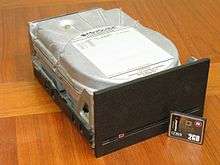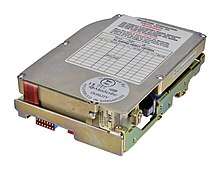MiniScribe
MiniScribe was a manufacturer of disk storage products, founded in Longmont, Colorado in 1980. MiniScribe designed and sold stepper motor-based hard disk drives with a large amount of onboard logic for the time. They eventually moved into higher-profile voice coil motor designs, and won major contracts with IBM. They were a relatively well-known brand through the early 1980s.

History
The company was started by Terry Johnson, who had a 20-year career in the hard drive business at such companies as IBM, Memorex and Storage Technology Corporation. MiniScribe became a major player when it won a series of contracts to supply IBM's PC division, and their subsequent rapid growth led to an initial public offering in late 1983, opening for trading in January 1984. However, slow sales of the IBM XT led IBM to dramatically scale back their orders late that year, forcing MiniScribe to lay off 26% of its staff and causing the value of the stock to plummet. Johnson left the company; at the time he stated that he had been planning to do this for some time and that his departure had "absolutely nothing" to do with IBM.[1] Johnson would later comment that "It's a very low inertia industry, you can blow your way into it and get blown out of it very quickly."[2] Roger Gower, recently promoted to President, took over the CEO role as well.[1]
Shortly thereafter the company was recapitalized with a $20 million investment from Hambrecht & Quist (H&Q), a venture capital firm. One of H&Q's officers was Quentin Thomas ("QT") Wiles, a turnaround specialist nicknamed "Dr. Fix-It". Wiles took over the CEO position from Gower, running the company remotely from his office in Sherman Oaks, Los Angeles, with a management team made up primarily of accountants.[3] The company soon returned to profitability, with sales increasing from $114 million at the height of IBM's orders, to $603 million by 1988, when they were named the most well-managed company in the disk drive industry.[4] Their major customer at this time was Compaq, but the company was also bidding for major contracts with Apple Computer and Digital Equipment Corporation (DEC).[5]
Problems
In January 1987, the company officers conducted a quick inventory in order to estimate their accounts prior to an independent review by a third party accounting firm, Coopers & Lybrand. Their internal inventory count showed that there was a shortfall of between $2 and $4 million. This implied the cost to produce those drives that did sell was higher than initially thought, which, if properly booked against sales, would mean their operating margins would be unimpressive. Instead of reporting this, a number of the managers decided to cover it up with various means. They produced an inflated inventory count, and then broke into the accountant's lock boxes and replaced their independent count to match their newly inflated numbers. The team continued to roll these numbers forward through the quarters, compounding the problem.[6]
In July 1987, Jesse Parker, director of far east operations, told Wiles that something was amiss. In August, Wiles travelled to Hong Kong and Singapore where he found a complete loss of control. The inventory count from that fall showed that the numbers had grown to $15 million, mostly in Colorado. A report was prepared to consider various solutions, but Wiles suggested that they continue hiding the problem, ordering all copies of the report be destroyed. This led to the company's most infamous cover-up; the managers rented a second warehouse in Colorado, where they personally packed 26,000 bricks into hard drive boxes and shipped them to Singapore in order to shore up the inventory count. After the count was complete, they recalled those serial numbers as defective units, but instead of writing them off, they checked them into inventory, along with other failed drives that had been returned.[6]

The company continued to post impressive numbers, but there were troubling signs. Among them was that the company continued to post improving operating margins while the rest of the hard drive industry was suffering from rapidly falling margins due to ongoing downward price pressure. In 1988 the board of directors became concerned when the company's reported receivables grew dramatically, indicating a large amount of unpaid billables, while at the same time inventories were also growing, indicating unsold product. Those two numbers are normally at odds; increased receivables should indicate increased sales, which would normally result in decreased inventory. The directors began an internal investigation in October, while the company reported another record-setting quarter for that period in spite of failing to win either the Apple or DEC contracts.[5]
The investigation revealed that Wiles set iron-clad sales forecasts and pushed these requirements down into the sales team, leaving no room for failure and setting bonuses on beating those figures. The sales team responded by "touching up" reporting documents as they moved back up the reporting chain. Wiles responded to these positive reports by setting even higher sales targets, leading to ever-increasing fraud to meet them.[4] Wiles eventually left the company in February 1989, followed by most of the company's officers over the next months. The directors report was released in the summer, stating that Wiles and his management team had "perpetrated a massive fraud" in a "company run amok".[7]
Among the other techniques used to improve the numbers were classic accounting tricks; failing to write off bad debts, shipping drives to warehouses and booking them as sales (channel stuffing), back-dating shipments to allow them to be booked in earlier reporting periods to meet goals, and deliberately shipping defective products repeatedly to different customers so one drive could be booked as multiple sales (leading employees to joke that the only thing being repaired were the worn-out cardboard boxes). When the company embarked on a round of layoffs just before the 1989 Christmas shutdown, including several of the employees who were involved in the brick scheme, they immediately called the Denver area newspapers, who broke the story. Following immediate investigations in Singapore and Colorado the fraud was confirmed.[4]
The company declared bankruptcy on 1 January 1990,[4] and was quickly liquidated with Maxtor acquiring its assets in a $46 million cash and stock deal in 1990.[8] In a subsequent court case, Wiles claimed to have known nothing of these schemes, saying he was duped by the middle management. However, several of those middle managers testified that Wiles was very much aware of the fraud. The court also noted that Wiles sold a considerable number of shares in the company in April and May 1988, immediately prior to reporting a shortfall due to an "elaborate scheme" to manipulate inventory shortfalls. Wiles was eventually convicted of fraud and insider trading.[3]
Founder Terry Johnson later helped found CoData with the intent of building a 3.5" hard drive with the capacity of then-standard 5.25" drives.[9] The company merged with Conner Peripherals in 1986[10] and as Conner Peripherals became a major vendor for a time. Johnson died piloting his small plane near Norman Wells in northern Canada on 24 July 2010.
References
- "Top Officer Quits At Miniscribe Corp.", New York Times, 11 December 1984
- Bro Uttal, "The Hard Times In Hard-Disk Drives", Fortune, 25 November 1985
- Patrice Apodaca, "Wiles Convicted of Fraud in MiniScribe Case", New York Times, 9 August 1994
- "Fraud Examination", Southwestern University, 2012
- "Cooking The Books: How Pressure To Raise Sales Led Miniscribe to Falsify Numbers", Wall Street Journal, 11 September 1989
- US vs. Wiles, US vs. Schleibaum
- "Fraud Is Cited at Miniscribe". AP. New York Times. 1989-09-13. Retrieved 2007-10-12.
- Company News; Maxtor Acquires Miniscribe Assets, NY Times, 2 July 1990
- Oral History Of Terry Johnson, Computer History Museum
- Computer Systems News and Electronic News, Feb 1986